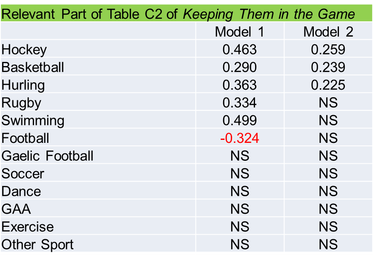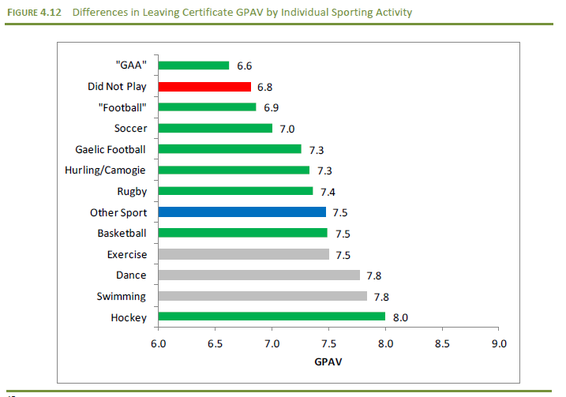
Team sports are the only ones that have a positive statistically significant relationship with Leaving Certificate results (measured as grade point average). The results show that hockey, basketball, and hurling are the only sports that show a statistical signifiant positive relationship with Leaving Certificate results. This can be seen in the column for Model 2 in the accompanying table. Model 2 is the more sophisticated econometric model as it includes control variables for school experience. The NS stands for not statistically significant.
The more basic model, without these controls, is Model 1. This model shows a statistically significant positive relationship between Leaving Certificate results and two other sports - rugby and swimming. The only statistically significant negative relationship shows up in this more basic model for the sport of 'football'. (The authors acknowledge problems with the data on 'football' as it is not clear what type of football it is.)
The above results are placed in the Appendix. However, the bar chart below was placed in the main text. This bar chart suggests that team sports are less important than individual sports for Leaving Certificate results. The grey coloured bars of the individual sports fill three of the top four positions. One would be forgiven for thinking that individual sports were correlated better with Leaving Certificate results than individual sports. The data from the Appendix says differently.
Most economists and statisticians would argue that Model 2 is better than Model 1; and that Model 1 is better that than the averages presented in the bar chart. It is a pity the positive relationship between basketball/hurling and Leaving Certificate results was not highlighted. It might help offset some of the less flattering ways these two sports were presented elsewhere, e.g. these two sports do poorly when it comes to drop-out rates as presented in Figure 7.3 in the research. Maybe this post redresses the balance in some very small way.

 RSS Feed
RSS Feed